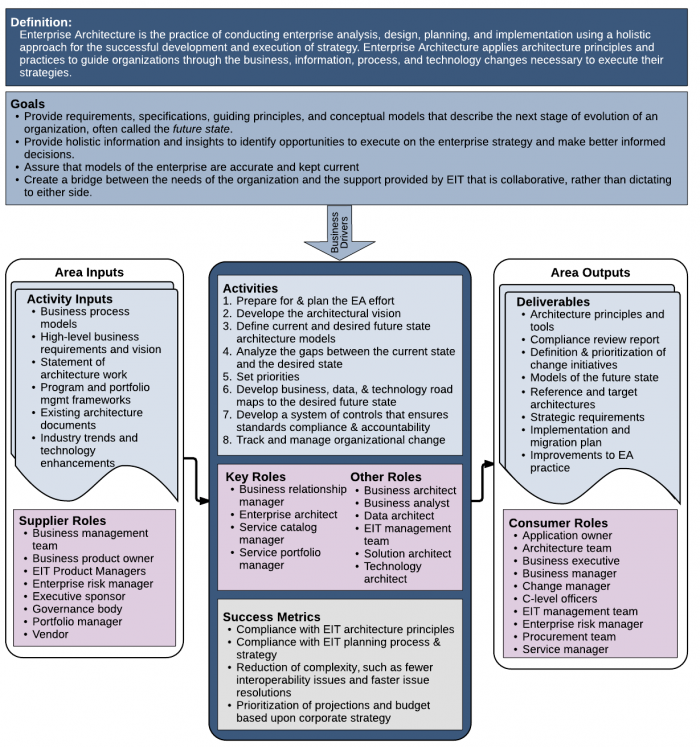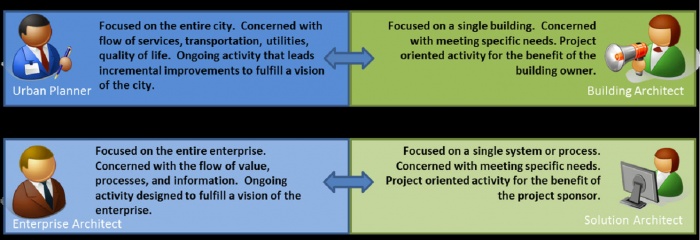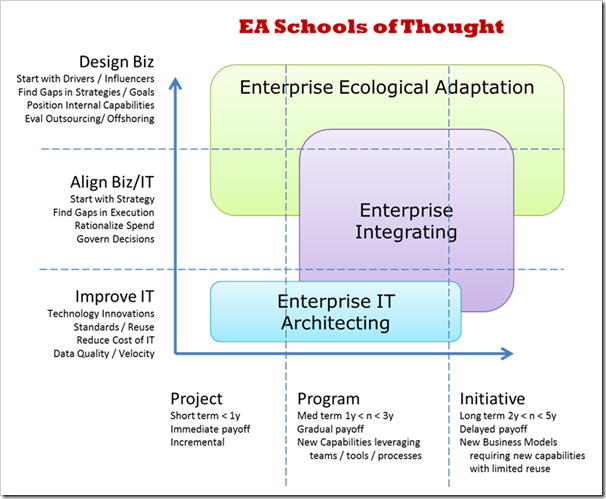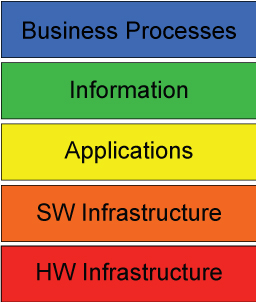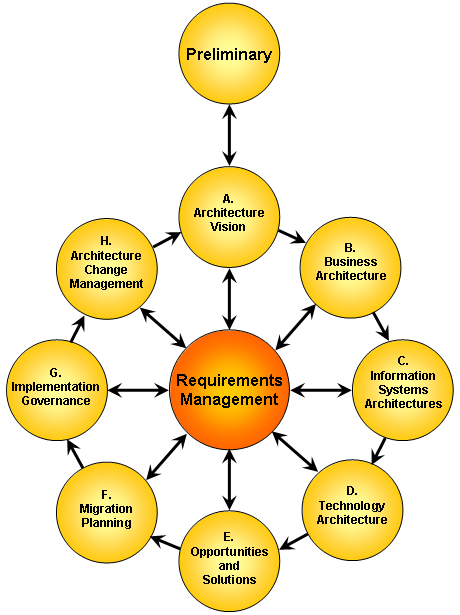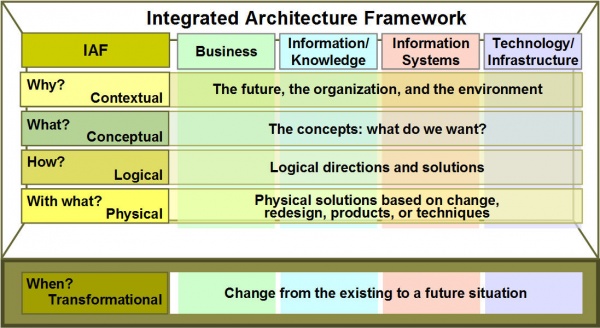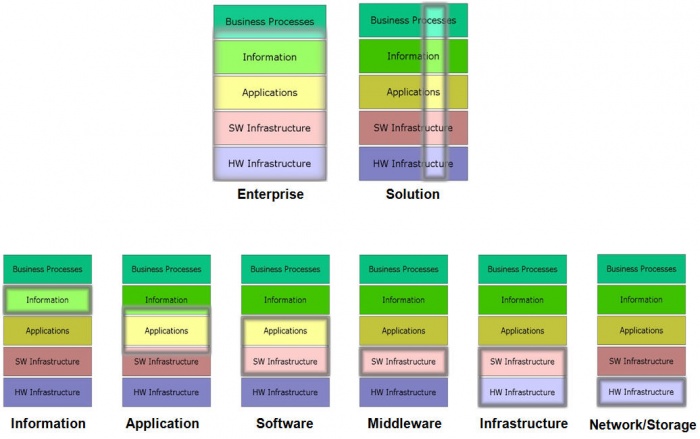Difference between revisions of "Enterprise Architecture"
| Line 180: | Line 180: | ||
<p>Successful EA functions must be able to balance high-level strategic work with tactical governance and collaboration with solution architectures in the enterprise’s IT portfolio so that the portfolio provides ongoing and clear impact and value.</p> | <p>Successful EA functions must be able to balance high-level strategic work with tactical governance and collaboration with solution architectures in the enterprise’s IT portfolio so that the portfolio provides ongoing and clear impact and value.</p> | ||
<p>A useful, practical, and functioning EA framework should have independent and modular elements, and, at the same time, be able to show an integrated and interdependent view of all of the elements.</p> | <p>A useful, practical, and functioning EA framework should have independent and modular elements, and, at the same time, be able to show an integrated and interdependent view of all of the elements.</p> | ||
| + | |||
<h2> Key Competence Frameworks</h2> | <h2> Key Competence Frameworks</h2> | ||
<p>While many large companies have defined their own sets of skills for purposes of talent management (to recruit, retain, and further develop the highest quality staff members that they can find, afford and hire), the advancement of EIT professionalism will require common definitions of EIT skills that can be used not just across enterprises, but also across countries. We have selected 3 major sources of skill definitions. While none of them is used universally, they provide a good cross-section of options. </p> | <p>While many large companies have defined their own sets of skills for purposes of talent management (to recruit, retain, and further develop the highest quality staff members that they can find, afford and hire), the advancement of EIT professionalism will require common definitions of EIT skills that can be used not just across enterprises, but also across countries. We have selected 3 major sources of skill definitions. While none of them is used universally, they provide a good cross-section of options. </p> | ||
| + | |||
<h3>Skills Framework for the Information Age</h3> | <h3>Skills Framework for the Information Age</h3> | ||
<p> The Skills Framework for the Information Age (SFIA) has defined nearly 100 skills. SFIA describes 7 levels of competency which can be applied to each skill. Not all skills, however, cover all seven levels. Some reach only partially up the seven step ladder. Others are based on mastering foundational skills, and start at the fourth or fifth level of competency. It is used in nearly 200 countries, from Britain to South Africa, South America, to the Pacific Rim, to the United States. (http://www.sfia-online.org)</p> | <p> The Skills Framework for the Information Age (SFIA) has defined nearly 100 skills. SFIA describes 7 levels of competency which can be applied to each skill. Not all skills, however, cover all seven levels. Some reach only partially up the seven step ladder. Others are based on mastering foundational skills, and start at the fourth or fifth level of competency. It is used in nearly 200 countries, from Britain to South Africa, South America, to the Pacific Rim, to the United States. (http://www.sfia-online.org)</p> | ||
<p>SFIA skills have not yet been defined for the security chapter.</p> | <p>SFIA skills have not yet been defined for the security chapter.</p> | ||
| + | |||
<h3>European Competency Framework</h3> | <h3>European Competency Framework</h3> | ||
| − | <p> The European | + | <p> The European Union’s European e-Competence Framework (e-CF) has 40 competences and is used by a large number of companies, qualification providers and others in public and private sectors across the EU. It uses five levels of competence proficiency (e-1 to e-5). No competence is subject to all five levels.</p> |
| − | < | + | <p>The e-CF is published and legally owned by CEN, the European Committee for Standardization, and its National Member Bodies (www.cen.eu). Its creation and maintenance has been co-financed and politically supported by the European Commission, in particular, DG (Directorate General) Enterprise and Industry, with contributions from the EU ICT multi-stakeholder community, to support competitiveness, innovation, and job creation in European industry. The Commission works on a number of initiatives to boost ICT skills in the workforce. |
| + | |||
| + | Version 1.0 to 3.0 were published as CEN Workshop Agreements (CWA). | ||
| + | The e-CF 3.0 CWA 16234-1 was published as an official European Norm (EN), EN 16234-1. | ||
| + | For complete information, please see http://www.ecompetences.eu. </p> | ||
| + | |||
| + | <table cellpadding="5" border="1"> | ||
| + | <tr> | ||
| + | <th width="20%">e-CF Dimension 1</th><th width="40%">e-CF Dimension 2</th><th width="40%">e-CF Dimension 3</th> | ||
| + | </tr> | ||
| + | <tr> | ||
| + | <td valign="top"><em><strong>D. Enable</strong></em></td> | ||
| + | <td valign="top">D.1. Title<br />Definition</td> | ||
| + | <td valign="top"><ul><li>Level 4: </li> | ||
| + | <li>Level 5: </li></ul></td> | ||
| + | </tr> | ||
| + | <tr><td valign="top">E. Manage</td> | ||
| + | <td valign="top">E.8. Title<br />Description </td> | ||
| + | <td valign="top"><ul><li>Level 2: </li><li>Level 3: </li><li>Level 4: </li></ul></td> | ||
| + | </tr> | ||
| + | |||
| + | </table> | ||
| + | |||
<h3>i-Competency Dictionary </h3> | <h3>i-Competency Dictionary </h3> | ||
| − | <p>The Information Technology Promotion Agency | + | <p>The Information Technology Promotion Agency (IPA) of Japan has developed the i-Competency Dictionary (iCD), translated it into English, and describes it at https://www.ipa.go.jp/english/humandev/icd.html. It is an extensive skills and tasks database, used in Japan and southeast Asian countries. It establishes a taxonomy of tasks and the skills required to perform the tasks. The IPA is also responsible for the Information Technology Engineers Examination (ITEE), which has grown into one of the largest scale national examinations in Japan, with approximately 600,000 applicants each year. </p> |
| + | |||
| + | <p>The iCD consists of a Task Dictionary and a Skill Dictionary. Skills for a specific task are identified via a “Task x Skill” table. (Please see Appendix A for the task layer and skill layer structures.) EITBOK activities in each chapter require several tasks in the Task Dictionary. </p> | ||
| + | |||
| + | <p>The table below shows a sample task from iCD Task Dictionary Layer 2 (with Layer 1 in parentheses) that correspond to activities in this chapter. It also shows the Layer 2 (Skill Classification), Layer 3 (Skill Item), and Layer 4 (knowledge item from the IPA Body of Knowledge) prerequisite skills associated with the sample task, as identified by the Task x Skill Table of the iCD Skill Dictionary. The complete iCD Task Dictionary (Layer 1-4) and Skill Dictionary (Layer 1-4) can be obtained by returning the request form provided at http://www.ipa.go.jp/english/humandev/icd.html. | ||
| + | |||
| + | <table cellpadding="5" border="1"> | ||
| + | <tr> | ||
| + | <th font-size="14pt">Task Dictionary</th><th colspan="3">Skill Dictionary</th> | ||
| + | </tr> | ||
| + | <tr> | ||
| + | <th width="30%">Task Layer (Task Area)</th><th width="15%">Skill Classification</th><th width="15%">Skill Item</th><th width="40%">Associated Knowledge Items</th> | ||
| + | </tr> | ||
| + | |||
| + | <tr> | ||
| + | <td valign="top"><em><strong>Information security operation management <br />(IT Operation Control)</strong></em></td> | ||
| + | <td valign="top">Operation of services</td> | ||
| + | <td valign="top">Information security | ||
| + | <td> <ul> | ||
| + | <li>Understanding and utilization of PKI technology trends</li> | ||
| + | <li>Access control (authentication, log monitoring, etc.)</li> | ||
| + | <li>Rules on installing applications (rules on the installation and use of applications on machines connected to the network)</li> | ||
| + | <li>Application security</li> | ||
| + | <li>Installation and administrative rules for public Internet servers (rules on installation standards and operational management of servers to be connected to the Internet)</li> | ||
| + | <li>Rules on Internet usage (rules on the use of e-mail and Internet access from the company)</li> | ||
| + | <li>Operational rules for measures against computer viruses (rules relating to measures against computer viruses for machines that exchange data externally)</li> | ||
| + | <li>Standards for Measures against Computer Viruses</li> | ||
| + | <li>Standards for Measures against Unauthorized Access to Computers</li> | ||
| + | <li>Understanding and utilization of single sign-on technology trends</li> | ||
| + | <li>Understanding and utilization of technology trends in security administration</li> | ||
| + | <li>Security tools (free, commercial)</li> | ||
| + | <li>Security test items</li> | ||
| + | <li>Data protection (encryption, transmission, etc.)</li> | ||
| + | <li>Network protection (firewalls, intrusion detection, etc.)</li> | ||
| + | <li>Understanding and utilization of firewall technology</li> | ||
| + | <li>Malware (viruses, spyware, worms, adware)</li> | ||
| + | <li>Encryption (DES)</li> | ||
| + | <li>Encryption (RSA)</li> | ||
| + | <li>Cryptography (common key, public key, private key, RSA, AES, hybrid encryption, hash functions, etc.)</li> | ||
| + | <li>Understanding and utilization of cryptography</li> | ||
| + | <li>Threat</li> | ||
| + | <li>Public key infrastructure (PKI, certificate authorities, digital certificates, etc.)</li> | ||
| + | <li>Attack methods (SQL injection, cross site scripting, DoS attack, phishing, targeted attacks, etc.)</li> | ||
| + | <li>Confidentiality, integrity, and availability</li> | ||
| + | <li>Understanding and utilization of technology trends in intrusion prevention</li> | ||
| + | <li>Government public key infrastructure (GPKI, Bridge Certification Authority, etc.)</li> | ||
| + | <li>Biometric authentication technology</li> | ||
| + | <li>Vulnerability</li> | ||
| + | <li>Copyright protection (CPRM)</li> | ||
| + | <li>Copyright protection (CSS)</li> | ||
| + | <li>Understanding and utilization of electronic signature technology</li> | ||
| + | <li>Authentication technology (digital signatures, message authentication, time stamps, etc.)</li> | ||
| + | <li>User authentication (ID, password, etc.)</li> | ||
| + | </ul> | ||
| + | </td> | ||
| + | </tr> | ||
| + | </table> | ||
| + | |||
<h2>Key Roles</h2> | <h2>Key Roles</h2> | ||
Revision as of 20:58, 3 July 2016
Note: This wiki is a work in progress, and may contain missing content, errors, or duplication.
Contents
- 1 Introduction
- 2 Goals and Principles
- 3 Context Diagram
- 4 What is Enterprise Architecture?
- 5 A Brief History of Enterprise Architecture
- 6 The Purpose and Value of Enterprise Architecture
- 7 The Conventional Wisdom
- 8 The Geography of Enterprise IT Architecture and Links to Other Disciplines
- 9 Summary
- 10 Key Competence Frameworks
- 11 Key Roles
- 12 Standards
- 13 References
- 14 Additional Reading
1 Introduction
Enterprise architecture (EA) is the practice of conducting enterprise analysis, design, planning, and implementation using a holistic approach for the successful development and execution of strategy. EA applies architecture principles and practices to guide organizations through the business, information, process, and technology changes necessary to execute their organization’s strategies.
Like many other disciplines, EA is evolving. [1] The EA concept dates back to the late 1980s as a response to the increased complexity associated with the introduction of distributed computing. For the first time, the unmanaged and uncontrolled replication of systems providing similar capabilities, as well as the same or very similar data sets were springing up around the enterprise. The result was increased difficulty in integrating and evolving systems to address changing business needs. The initial EA concept was to adopt an enterprise-wide view of an organization’s computing resources. By developing and applying standards and governance throughout the organization, unnecessary complexity and redundancy could be avoided.
EA provides this enterprise-wide view. Although it was initially motivated by the need to control EIT expense, EA is now also driven by the need for improved IT innovation, effectiveness, and efficiency in a rapidly changing business and technology environment. If done well, an organization’s enterprise architecture provides context for all the enterprise’s IT activities.
While there are a number of frameworks, practices, and approaches for EA, there is a generally accepted body of conventional wisdom on the subject, and this chapter introduces the basic concepts.
2 Goals and Principles
- To assure that models of the enterprise are accurate and kept current
- To provide artifacts such as requirements, specifications, guiding principles, and conceptual modes that describe the next stage of evolution of an organization, often called the future state or to be state.
- To provide the holistic information and insights to identify opportunities to execute on the enterprise strategy and make better informed decisions.
- To create a collaborative bridge between the needs of the organization and the support provided by EIT, rather than dictating to either side.
3 Context Diagram
Figure 1. Context Diagram for Enterprise Architecture
4 What is Enterprise Architecture?
4.1 The Concept of Enterprise
The first definition listed in a dictionary for enterprise is generally some variation on the concept of an ambitious endeavor or undertaking. Subsequent definitions define it as the entity (typically an organization) that carries out such an undertaking. This latter definition is the common understanding of the meaning of enterprise within the EA community. More specifically, it is an entity that can be reasonably well modeled as comprising the business and EIT, including such organizations as governments and nonprofits within its compass.
4.2 The Concept of Architecture
The formal definition of architecture cited most frequently by the EA community is the definition from ISO/IEC/IEEE 42010:2011:
“... “architecture” means whatever the framework being used (explicitly or implicitly) implies it is by the various architectural representations it recommends for use. ” [2]
4.3 A Definition of Enterprise Architecture
The Federation for Enterprise Architecture Professional Organizations (FEAPO) defines EA as follows:
“Enterprise architecture is a well-defined practice for conducting enterprise analysis, design, planning, and implementation, using a holistic approach at all times, for the successful development and execution of strategy. Enterprise architecture applies architecture principles and practices to guide organizations through the business, information, process, and technology changes necessary to execute their strategies. These practices utilize the various aspects of an enterprise to identify, motivate, and achieve these changes.” [3]
Analogies between enterprise architecture and urban planning have been made, because both define common guidelines, standards, and frameworks with which solution architects and building architects, respectively, must comply (see Figure 2).
Figure 2. Urban Planner and Enterprise Architect versus Building Architect and Solution Architect [3]
5 A Brief History of Enterprise Architecture
The need for enterprise architecture arose for two separate reasons. The first reason was driven by technology. The arrival of distributed computing in the 1980s resulted in increased IT complexity due to additional scale, diversity, and connectivity in the computing environment. The additional complexity lead to significantly higher EIT development, support, and operational costs. With rising costs came pressure from management to slow the growth of EIT budgets and increase the business effectiveness of EIT support. Directives to “do more with less” and unrelenting pressure to increase efficiency and effectiveness required new approaches to EIT strategy. To some extent, consolidation, standardization, and commoditization worked as EIT expense reduction strategies; however, there were limits to their effectiveness, because they still lacked a holistic and systematic understanding of the connectedness between business roles and processes, information data elements and flows, supporting application systems, and underlying technology infrastructure.
The second motivation for EA was business-driven, due to the ever-increasing pace of external change combined with the difficulty for many organizations to successfully execute their business strategies. Michael Porter estimates that more than 80 percent of organizations fail to execute their business strategies, and ineffective execution was the reason for failure for more than 70 percent of them. [4] The principles and practices in EA help enterprise managers move their organizations from where they are to where they want them to be.
Based on whether one views EA solely for technology-based or business strategy-based reasons, the scope of EA, including its concerns, assumptions, and limitations varies. One of the most cogent analyses of the range of EA definitions was presented by James Lapalme, who describes three schools of thoughts on EA: [5]
- Enterprise-wide IT platform (effective enterprise strategy execution and operation through EIT-business alignment)
- Enterprise (effective enterprise strategy implementation through execution coherency)
- Enterprise-in-environment (innovation and adaptation through organizational learning)
Nick Malik builds on Lapalme’s three schools, and describes three categories of EA application: [6]
- Enterprise IT architecting
- Enterprise integrating
- Enterprise ecological adaptation
These differences between these categories vis depicted graphically in Figure 3.
Figure 3. EA Schools of Thought [6]
EA can serve a number of different goals (the vertical axis of Figure 3) and can provide direction and support for a range of time horizons and enterprise value (the horizontal axis). It is important to distinguish the type of EA that an organization needs and wants to establish. By doing so, the boundaries and handoffs between EA and business executives in the execution of their business strategy, as well as between EA and EIT governance and strategy, are clear. Without that clarity, ongoing confusion and issues with collaboration and alignment will likely be created.
Regardless of the school of thought, a framework for EA is needed to describe the interconnectedness of the business, information, systems, and technology elements (often called artifacts). In 1987, John Zachman published what is commonly viewed as the first framework describing a classification scheme for artifacts at several levels of abstraction. [7] In the 1990s, a reference model was developed for EA by and for the US Department of Defense (DoD) called the Technical Architecture Framework for Information Management (TAFIM).
In 1995, based on TAFIM, The Open Group Architecture Framework (TOGAF) had its first release. Since then, TOGAF has evolved and released TOGAF 9.1 in 2011. It maintains that “a complete EA description should contain all four architecture domains (business, data, application, technology), but the realities of resource and time constraints often mean there is not enough time, funding, or resources to build a top-down, all-inclusive architecture description encompassing all four architecture domains, even if the enterprise scope is ... less than the full extent of the overall enterprise.” [9]
While TOGAF may be the most popular EA framework (based on published certification numbers), there are many different frameworks available. Generally, they fall into these types: consortia-developed (e.g., TOGAF), defense industry (e.g., DODAF (U.S.)), government (e.g., E-overheid NORA (Dutch), open-source (e.g., MEGAF), and proprietary (e.g., Capgemini’s IAF). [10]
6 The Purpose and Value of Enterprise Architecture
As noted in the Introduction, the driving force behind enterprise architecture has changed since its initial appearance. Four purposes or value propositions for EA are frequently given:
- Manage, if not master complexity
- Ensure business/EIT alignment
- Facilitate successful organizational change, transformation, and agility
- Bridge strategy and execution
A common comparison is with city planning, where EA maintains the “master plan” for the enterprise’s business/technology integration.
6.1 Manage Complexity
The elimination of unnecessary complexity was the earliest justification for EA. Eliminating complexity makes systems easier to understand, easier to control, and, therefore, less expensive to develop, operate, and maintain. In a large organization with multiple units, different systems and business processes often start at different times or in different geographies. For example, an organization might have multiple human resource (HR) systems, overlapping sales forecasting systems, or disconnected procurement systems. An EA-based framework and roadmap supports the elimination of redundancy as well as the integration of systems and data.
6.2 Business and IT Alignment
In an effort to speak the language of the enterprise's business, the complexity reduction rationale fell into disuse as the EA community shifted its focus of the value proposition for EA to business and IT alignment. The alignment rationale has become increasingly widespread, and remains the dominant value proposition for EA. One important alignment activity is the mapping of business roles and processes to information data flows and the underlying EIT systems and technology that support them.
6.3 Change, Transformation, and Agility
Another justification for EA has been the support of change and transformation via organizational agility. In a business and technology environment of continuous and rapid change, organizations that can anticipate and respond appropriately and quickly are more likely to survive. Robust EA processes can support rapid change.
The belief is that changes in the business environment can require “disruptive” changes in the EIT environment, and therefore, a strategically agile EIT function enables agility in the entire organization. The motivation for disruptive change can come from new competition, a merger or acquisition, or a new technology that the business wants to adopt. The push for change can come from either the business or IT; but because of this important symbiotic relationship between the enterprise and EIT, it is important for both to be agile and able to adapt quickly to change.
6.4 Strategy and Execution
A major function of EA is revealing and documenting the relationships between business elements, information elements, and the underlying information technology and technology infrastructure. By demonstrating these interrelationships from a systems level down to the most detailed element or artifact level, EA provides the information needed to connect an organization’s conceptual business strategy to the execution of that strategy.
Over the last several decades, enterprises of all types, whether in manufacturing, finance, HR, or systems integration, have moved from vertically integrated entities to horizontally interdependent supply chains. [15] The ways that enterprises compete and what they create internally versus what they source externally has moved from physical elements and on-site infrastructure to applications and off-site data centers. This change started with hardware infrastructure, moved into software infrastructure, and continued into applications, information, and even specialized business functions. EA methodologies help EIT and enterprise management see the connection between business processes and the EIT services those processes depend on, thereby enabling the transformation.
7 The Conventional Wisdom
There are three almost universally adopted concepts that characterize the current state of the art of enterprise architecture:
- The four layer stack model (the four aspects) of an enterprise
- The delineation of as is and to be states
- The use of frameworks
7.1 The Umbrella Nature of Enterprise Architecture: Layers or Aspects
The conventional model (called the BIAT model [1]) of an organization’s EA is sometimes represented as a four layer horizontal stack (see Figure 4).
Figure 4. Conventional BIAT Diagram (Note: In some diagrams, the layers are shown vertically and might be called domains or aspects.)
7.1.1 Business Layer
Within the EITBOK, the term business is used synonymous with enterprise. While it may seem odd, it appears that there is no universally excepted definition of business within the EA community. Instead, the EA community simply knows what business means; however, some sense of what business is, can be inferred from the stack metaphor — it is whatever is ultimately supported by the technology layer.
7.1.2 Data or Information Layer
In the BAIT model, information is associated with business information and other valuable stored data. Every enterprise runs on information, and therefore, the patterns of information used by the business largely determine the data technology required to support the information needs.
7.1.3 Applications Layer
Software applications consume, transform, and produce data or information needed by the enterprise's technology users. Often, the heaviest information "consumers" are in HR and finance units, although software increasingly supports facilities management, inventory control, customers, and vendors.
7.1.4 Technology Layer
The technology domain includes processors, storage and network connectivity, and the middleware that provide the basic computing and communications capabilities for the enterprise. They enable the flow of information that is the lifeblood of the organization. Note that the EIT technology domain thus does not typically include physical process technology such as industrial or manufacturing automation technologies.
7.1.5 Where the Action Is
Three unstated presumptions of the BIAT model are that
- The transformative value of EA is typically delivered by transforming the application and technology layers,
- The agility of the enterprise is a consequence of agility of the EIT function, and
- The alignment of the business and EIT is achieved by "aligning EIT" with the business.
It is common within the EA community to recognize that each of these layers has its own architecture, and that the enterprise architecture is in some sense the sum or union of all these architectures. At the same time, it is also commonly stated within the EA community that the enterprise consists of businesses + IT, and therefore, that the enterprise architecture is comprised of business architecture + IT architecture. Digging deeper IT architecture is comprised of data/information architecture, applications architecture, and technology architecture, although it is often agreed that the data/information architecture can straddle the boundary between the business and EIT domains).
The stack metaphor is derived from the idea that the technology architecture is ultimately driven by the needs of the business domain/architecture (an expression of the business/EIT alignment rationale), with the data/information and applications architectures as key waypoints.
There are several different models in use for how this integration across the layers or aspects is best achieved. One of the most common is the service model, in which each layer delivers services to the layers above it. Not surprisingly, the question of what exactly makes something a service remains a subject of considerable discussion. Other models focus on the enterprise’s value chain, also known as enterprise capabilities.
Figure 5 depicts a variation of the conventional BIAT diagram. It shows that the focus of EA practice is on business processes. It also divides the technology domain into software and hardware infrastructure, because they are qualitatively different in nature. This diagram is used later to illustrate the relationship between EA and other enterprise-related architectures.
Figure 5. Modified BIAT Diagram
7.2 The As Is and To Be States
As noted earlier, EA serves a key role in organizational transformation by bridging strategy to execution. (You can’t get where you want to go unless you know where you are.) Essentially, one needs to understand the current as is state relative to the desired to be state, identify the gaps, and chart a plan or roadmap to get from today’s state to the future. The Open Group describes an approach that it calls the Architecture Development Model (ADM) that consists of a number of iterative phases, as shown in Figure 6. [14]
Figure 6. TOGAF 9.1 ADM Steps [14]
7.3 Evolving Frameworks
Instead of using the different layers of the BIAT model, several frameworks add a second (vertical) dimension that connects the architectural aspects of BIAT with the specifics of when and how to create and use the architecture. Two examples are provided: the Zachman Framework, which is one of the first frameworks for EA, and a simpler version, the Integrated Architecture Framework (IAF). In both frameworks, the layers ultimately extend from the enterprise perspective down to the technical implementations through requirements management and construction:
- Contextual — the why; the connection to the business strategy and principles
- Conceptual — the what; the service level
- Logical — the how; the logical flows
- Physical — the with what; the specific elements
Figure 7 shows a more detailed and complex framework, in which the business, information, applications, and technology are vertical "domains" rather than layers. This is the Zachman Framework, and it was groundbreaking when it was introduced. [11]
Figure 7. Zachman Framework for Enterprise Architecture [11]
Figure 8 depicts the Integrated Architecture Framework (IAF) in less detail than the Zachman Framework figure. [12] In this diagram, the BIAT aspects are shown vertically and the horizontal layers depict varying degrees of abstraction: contextual (the why), conceptual (the what or service layer), logical (the how including processes), and, finally, the physical (the with what layer). Adding the transformational (the when), it includes the dynamic dimension, from the current or existing state to the future state.
Figure 8. Integrated Architecture Framework [13]
With these additional layers, different perspectives and dimensions of detail become more apparent than in the simple BIAT model.
8 The Geography of Enterprise IT Architecture and Links to Other Disciplines
Enterprise architecture is valuable and useful if it influences and integrates the inputs and outputs of other architecture disciplines into the enterprise, as well as bridges between the enterprise strategy and the IS/EIT projects.
8.1 The Relationship between EA and Other Architectures
A recent survey conducted by the Journal of Enterprise Architecture asked survey respondents for their titles. Among the respondents who had architect in their title, there were 21 different non-level-related modifiers. Labels that architects use rather than enterprise architect include business process architect, information architect, applications architect, solution architect, software architect, middleware architect, infrastructure architect, network architect, network storage architect, and hardware architect.
Figure 9 shows that the simple view of enterprise architecture (first introduced in Figure 5) also describes other typical architecture types. All of them must consider solution, information, application, software, middleware, infrastructure, and network storage.
Figure 9. Enterprise and Other Enterprise-related Architectures
8.2 The Relationship between Enterprise Architecture and Enterprise IT
EA serves as a bridge between the enterprise’s vision and strategy and how the underlying layers of business elements (including business processes and people) are organized, as well as the flow of information and data elements. Business processes and information are not necessarily automated with IS/IT. For example, without IS/IT automation, workers can manually take measurements, create reports, and deliver data and information in those reports. On the other hand, where business process and information flows are automated with IS/EIT, EA describes the interdependencies and linkages between the business (organization), information, applications, and technology infrastructure.
In contrast, enterprise IT (EIT) consists of the applications and technology infrastructure that supports the applications, so today EIT is increasingly seen as a subset of EA.
Distinguishing between EA and EIT is important, and by doing so, an organization should clearly recognize that there is a choice to either support business roles, business processes, and information flows with automation (i.e., IS/EIT) or keep them manual. Likewise, the governance and influence of EA is different than the governance and influence of EIT.
Artifacts (i.e., outputs or deliverables) from EA are found as inputs to strategy and governance as well as requirements (and subsequently, construction). Here are some examples:
- Strategy maps
- Capability maps
- Information maps
- Value maps
- Heat maps
- Organization maps
- Operating models
- Product maps
- Stakeholder maps
- Process models
- Dynamic rules based routing maps
- Data models
- Network models
- Systems models
- Vitality and renewal plans
- A wide range of hybrid blueprints and models with specialty uses based on the challenge at hand
8.3 Solutions and Their Relationship to EA
There are different ways to view the landscape of the enterprise’s IT architecture. At the fundamental level, EA physical and logical artifacts describe the elements that support the organization’s operations. At a more conceptual level, there are the business, information, information technology, and infrastructure services. These can be related to an organization’s capabilities. Relatively speaking, these can be characterized in a colored heat map that uses color to represent different attributes or identify focus areas in a data set. Depending on the organization’s strategy, the capabilities that are most in need of improvement might be the first priority. Improvement/replacement costs, interdependencies with other capabilities and systems, risks of not improving, and so on are inputs to the prioritization process. The funding and governance of the improvement work (in the form of projects and programs) are strongly influenced by EA and typically overseen by a program management office (see the Change Strategy and Governance chapter). The projects and programs develop solution architectures and these solution architectures need to be compliant to and synergistic with the evolving enterprise architecture.
8.4 EA and Nonfunctional Requirements or Cross-layer Concerns
The Requirements chapter discusses the two types of requirements, functional and non-functional. While EA influences both types, its impact on functional requirements is more obvious. However, EA also influences nonfunctional requirements and can do so through the overriding EA principles as well as in what are called collaboration contracts between EA artifacts. Here are some examples.
- Business service collaboration contracts: A business service, or a set of business processes like a financial operation and its expectations in receiving information data elements from a sales service (e.g., an order entry from a sales operation).
- Technology infrastructure component collaboration contracts: Storage components and networking components. Collaboration contracts between the two might be the quality and reliability expectations in terms of up time, error-free processing, messaging, latency, and so on.
In these contracts, expectations of various qualities are defined and documented in delivery projects as nonfunctional requirements. By keeping the close association between the collaboration contracts of all the artifacts in the EA repository with the nonfunctional requirements in the enterprise IT portfolio of projects, the quality requirements and expectations across the enterprise can be balanced.
8.5 EA and Business Architecture and BPM
The discipline of EA has evolved in parallel to the discipline of business process modeling (BPM). Clearly, the business architecture needs to be characterized and described in both EA and BPM “languages” and tools. Over the last decade, this relationship has been recognized and the companies who are developing and providing EA and BPM tools are helping to bridge the gap. Likewise, the respective expert communities recognize the need and are starting to address it.
8.6 EA and Scope
It is important to note that EA does not necessarily mean across an entire enterprise. EA can be narrowed to a particular “subject of concern” and a “scope” for that concern. Enterprise can be the scope (“enterprise-wide”) and, in a different way, it can be viewed as the subject. TOGAF goes into detail about the different ways of looking at EA. Overall, remember that the organization is the definer of scopes, whether it is an extended organization, specific organization, business unit, function, or department. EA is not necessarily enterprise-wide. And orthogonally, the scope can be narrow and needs to be defined in terms of domains to be considered, such as business, information, data, application, platforms, infrastructure (software and hardware), and technology (network and storage). It may depend on whether the EA team is EIT-centric or enterprise-centric. Also, there are sometimes several EA teams working simultaneously on small chunks that must be integrated.
9 Summary
There are three almost universally adopted concepts that characterize the current state of the art of enterprise architecture:
- The four-layer stack model — or the four aspects — of an enterprise
- The as is and to be states
- The use of frameworks
Enterprise architecture should clearly influence and be influenced by strategy and governance. Additionally, there is a strong connection to requirements. Likewise, an interdependency exists between the enterprise architecture and the solution architecture (SA) for a particular application (solution architecture is included in the Construction chapter).
Enterprise architecture can be defined by its scope and subject; it can be about an entire organization or can be narrowed down to a segment, unit, or function. So EA is scalable and can be small and incremental as well as enterprise-wide.
EA can assist in both short- and long-term enterprise improvement and transformation planning.
Successful EA functions must be able to balance high-level strategic work with tactical governance and collaboration with solution architectures in the enterprise’s IT portfolio so that the portfolio provides ongoing and clear impact and value.
A useful, practical, and functioning EA framework should have independent and modular elements, and, at the same time, be able to show an integrated and interdependent view of all of the elements.
10 Key Competence Frameworks
While many large companies have defined their own sets of skills for purposes of talent management (to recruit, retain, and further develop the highest quality staff members that they can find, afford and hire), the advancement of EIT professionalism will require common definitions of EIT skills that can be used not just across enterprises, but also across countries. We have selected 3 major sources of skill definitions. While none of them is used universally, they provide a good cross-section of options.
10.1 Skills Framework for the Information Age
The Skills Framework for the Information Age (SFIA) has defined nearly 100 skills. SFIA describes 7 levels of competency which can be applied to each skill. Not all skills, however, cover all seven levels. Some reach only partially up the seven step ladder. Others are based on mastering foundational skills, and start at the fourth or fifth level of competency. It is used in nearly 200 countries, from Britain to South Africa, South America, to the Pacific Rim, to the United States. (http://www.sfia-online.org)
SFIA skills have not yet been defined for the security chapter.
10.2 European Competency Framework
The European Union’s European e-Competence Framework (e-CF) has 40 competences and is used by a large number of companies, qualification providers and others in public and private sectors across the EU. It uses five levels of competence proficiency (e-1 to e-5). No competence is subject to all five levels.
The e-CF is published and legally owned by CEN, the European Committee for Standardization, and its National Member Bodies (www.cen.eu). Its creation and maintenance has been co-financed and politically supported by the European Commission, in particular, DG (Directorate General) Enterprise and Industry, with contributions from the EU ICT multi-stakeholder community, to support competitiveness, innovation, and job creation in European industry. The Commission works on a number of initiatives to boost ICT skills in the workforce. Version 1.0 to 3.0 were published as CEN Workshop Agreements (CWA). The e-CF 3.0 CWA 16234-1 was published as an official European Norm (EN), EN 16234-1. For complete information, please see http://www.ecompetences.eu.
| e-CF Dimension 1 | e-CF Dimension 2 | e-CF Dimension 3 |
|---|---|---|
| D. Enable | D.1. Title Definition |
|
| E. Manage | E.8. Title Description |
|
10.3 i-Competency Dictionary
The Information Technology Promotion Agency (IPA) of Japan has developed the i-Competency Dictionary (iCD), translated it into English, and describes it at https://www.ipa.go.jp/english/humandev/icd.html. It is an extensive skills and tasks database, used in Japan and southeast Asian countries. It establishes a taxonomy of tasks and the skills required to perform the tasks. The IPA is also responsible for the Information Technology Engineers Examination (ITEE), which has grown into one of the largest scale national examinations in Japan, with approximately 600,000 applicants each year.
The iCD consists of a Task Dictionary and a Skill Dictionary. Skills for a specific task are identified via a “Task x Skill” table. (Please see Appendix A for the task layer and skill layer structures.) EITBOK activities in each chapter require several tasks in the Task Dictionary.
The table below shows a sample task from iCD Task Dictionary Layer 2 (with Layer 1 in parentheses) that correspond to activities in this chapter. It also shows the Layer 2 (Skill Classification), Layer 3 (Skill Item), and Layer 4 (knowledge item from the IPA Body of Knowledge) prerequisite skills associated with the sample task, as identified by the Task x Skill Table of the iCD Skill Dictionary. The complete iCD Task Dictionary (Layer 1-4) and Skill Dictionary (Layer 1-4) can be obtained by returning the request form provided at http://www.ipa.go.jp/english/humandev/icd.html.
| Task Dictionary | Skill Dictionary | ||
|---|---|---|---|
| Task Layer (Task Area) | Skill Classification | Skill Item | Associated Knowledge Items |
| Information security operation management (IT Operation Control) |
Operation of services | Information security |
|
11 Key Roles
<p>Both SFIA and the e-CF have described profiles (similar to roles) for providing examples of skill sets (skill combinations) for various roles. The iCD has described tasks performed in EIT and associating those with skills in the IPA database.The following roles are common to ITSM.
- Enterprise Architect
- Service Portfolio Manager
- Service Catalog Manager
- Business Relationship Manager
12 Standards
ISO 15704:2000, Industrial automation systems – Requirements for enterprise-reference architectures and methodologies
ISO/IEC/IEEE 42010:2011, Systems and software engineering – Architecture description
TOGAF® Version 9.1, available at http://www.opengroup.org/togaf/downloads
13 References
[1] L. Fehskens, “Why We Can’t Agree on What “Enterprise Architecture” Means, and Why That’s OK, At Least for Now,” Enterprise Architecture Conference Europe, London June 2013.
[2] ISO/IEC/IEEE, “ISO/IEC/IEEE 42010:2011, Systems and software engineering — Architecture description,” http://www.iso.org/iso/catalogue_detail.htm?csnumber=50508
[3] Federation of EA Professional Organizations (FEAPO), “Common Perspectives on Enterprise Architecture,” Architecture and Governance Magazine, Issue 9-4, November 2013, pp.11-17.
[4] M. Porter, “The Five Competitive Forces that Shape Strategy,” Harvard Business Review, January 2008, pp. 79-83.
[5] J. Lapalme, “Three Schools of Thought on Enterprise Architecture,” IT Professional, vol.14, no. 6, pp. 37-43, Nov.-Dec. 2012, doi:10.1109/MITP.2011.109.
[6] N. Malik, “Three Schools of Thought for Enterprise Architecture,” blog, 28 May 2012; http://blogs.msdn.com/b/nickmalik/archive/2012/05/28/three-schools-of-thought-for-enterprise-architecture.aspx
[7] J. Zachman, “A Framework for Information Systems Architecture,” IBM Systems Journal, vol 26, no 3, 1987, IBM Publication G321-5298.
[8] The Open Group (January 23, 2015),“A Historical Look at Enterprise Architecture with John Zachman” http://blog.opengroup.org/2015/01/23/a-historical-look-at-enterprise-architecture-with-john-zachman/
[9] The Open Group (2011),“TOGAF 9.1, Part 11: Architecture Development Method (ADM) — Preliminary Phase” http://pubs.opengroup.org/architecture/togaf9-doc/arch/chap05.html
[10] Enterprise Architecture Framework, Wikipedia, http://en.wikipedia.org/wiki/Enterprise_architecture_framework
[11] This image is copyright John A. Zachman and Zachman International®, Inc. Published with the permission of John A. Zachman and Zachman International®, Inc., www.zachman.com
[12] J. van’t Wout et al, “The Integrated Architecture Framework Explained,” Springer-Verlag, 2010.
[13] Dekker, Morsink & Partners, http://www.dekkermorsink.nl/raamwerken.htm
[14] The Open Group, TOGAF9.1 ADM Steps Reference Card
[15] C. Fine, “Clockspeed,” Perseus Books, 1998.
14 Additional Reading
Schekkerman, “How to Survive in the Jungle of Enterprise Architecture Frameworks,” Trafford
Ross Weill and Robertson, “Enterprise Architecture as Strategy,” Harvard Business School Press.
